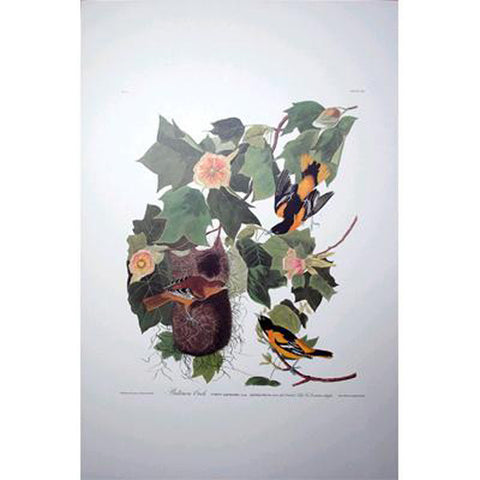Description
Northern Oriole, Icterus galbula
Flora: tulip tree, Liriodendron tulipifera
Print size: 26 1/4" x 39 1/4"; image size: 19 1/2" x 24 3/4"
Princeton Audubon Limited Edition - produced 1985
This print, of two male orioles and a female (shown clinging to the nest), is from a composition painted in Louisiana in 1822 and completed in 1825. The artist, Joseph Mason, also worked on the background.
More than half a century earlier, the Swedish naturalist Linnaeus, in a scientific description of this orange and black American oriole, had named the bird in honor of Cecil Calvert, second Baron of Baltimore, because Lord Baltimore's family colors were also orange and black.
Now known as the northern oriole, its mellow whistle, loud, clear, and rather low-pitched, is a sure sign of the retreat of winter. The nest is a remarkable example of design and craftsmanship created by the female alone. First, she ties suspension strings to a long, sweeping branch, forming the warp through which to weave an assortment of plant fibers, milkweed stalks, strips of bark, horse hair, or cord. The completed structure is gourd shaped, gray colored, and lined with feathers, plant down, or wool. Audubon noted that in the South the birds built a loosely-woven nest, "in such a manner that the air can easily pass through it," yet, if farther North, "they would have formed it of the warmest and softest materials."
EHJ
Princeton Audubon prints are direct-camera facsimile lithographs of the Robert Havell Jr. (1793-1878) engravings for The Birds of America (1827-38). Princeton's Double elephant Folio prints are issued in limited editions of 500 or 1500 prints. All are numbered and have a seal in the bottom margin to demonstrate their authenticity.
Printed on heavy Mohawk paper that is recommended by the Library of Congress for archives, the paper is specially toned to match the average paper color of the antique originals.
Item Number:
1704


